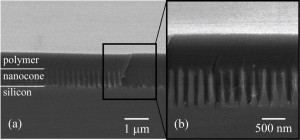Nanostructured materials can have unique properties that are not possible using macroscale materials. Some examples can be found in nature, where the surface texture and geometry of various organisms have evolved over time to optimize for certain operations. Our research approach is to first understand the physical origins, and then improve on nature’s design by using first-order scaling laws, rigorous analytical models, finite element methods, and numerical optimization routines.
Multifunctional Nanostructured Glass

One example we have demonstrated is nanostructured glass with both improved optical and wetting properties. The nanostructured glass is anti-fogging, self-cleaning, anti-glare, and has enhanced transmission [1]. The surface of the glass consists of high aspect-ratio periodic nanocone array, shown above. Such structures can have many applications in more efficient solar systems, high performance glass, and display.
Eliminating Thin-Film Iridescence Effects
We have also used the same principle to suppress thin-film interference and enhance transmission in multilayer films. Such iridescence effects are due to wave interference from reflections from multiple interfaces, and can be commonly observed in gasoline on water and soap bubbles. Using interfacial nanostructures, as shown above, such effects can be suppressed [2]. Here a nanocone structure is embedded between a polymer-silicon interface. Shown below, a bare silicon wafer appears colorless due to its broadband reflectance. A silicon substrate with a thin film coating, shown in the middle, appears to have color due to its wavelength dependent reflection. The color shifts when changing viewing angle, characteristics of thin-film interference. After embedding the interfacial nanostructure, the color effects is removed as shown in the left sample.
[1] K.-C. Park, H. J. Choi, C.-H. Chang, R. E. Cohen, G. H. McKinley, and G. Barbastathis, “Nanotextured Silica Surfaces with Robust Superhydrophobicity and Omnidirectional Broadband Supertransmissivity,” ACS Nano, 6, no. 5, 3789–3799 (2012). Top-10 most read article of 2012. [link]
[2] Q. Yang, X. A. Zhang, A. Bagal, W. Guo, and C.-H. Chang, “Antireflection effects at nanostructured material interfaces and the suppression of thin-film interference,” Nanotechnology, 24, 235202 (2013). [link]

